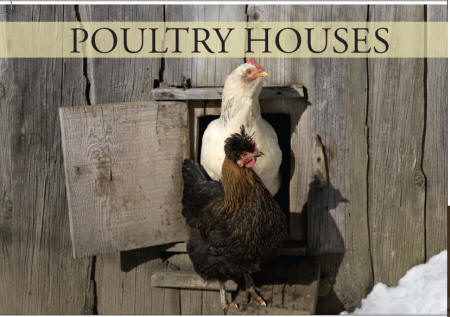
Poultry houses should be warm, dry, well-lighted, and ventilated shelters with convenient arrangements for roosts, feeding space, and nest boxes. In winter, if you’re living in a cool climate, light and warmth are of the upmost importance. Fowl will stop laying eggs and their health will suffer when confined in cold, wet, and dark conditions. Windows facing the south or southeast, large enough to admit the sun freely, should be provided and made to slide open to increase circulation during the summer.
Beyond these few requirements, houses for your poultry can be made in a variety of ways and are, generally, relatively easy to construct. Below are many different types of poultry houses that can be used to keep your fowl warm, dry, and healthy.
Simplest Poultry House
While poultry can survive in this type of cheaply and simply built coop, it is best used in warmer climates, where the winter months do not become incredibly cold and not much, if any, snow falls. Also, this type of coop is best suited for only one or two chickens or ducks.
Materials
• Four pieces of 1 x 2-inch boards for the studs and rafters
• Strong nails
• Wire netting
• Tarred paper
1. Take two of the boards and nail them together in a T shape. Repeat with the other two. Set these apart from each other about 2 feet 10 inches on the centers, and cover them with tightly drawn wire netting (cut to size).
2. Cover the wire netting with tarred paper, creating a barrier between the outside winds and weather and the fowl inside.
Young Poultry Coops
Chicks need extra warmth and protection from predators. This coop, if it houses small chicks, should not hold the other fowl, as they may bully or even harm the young chicks.
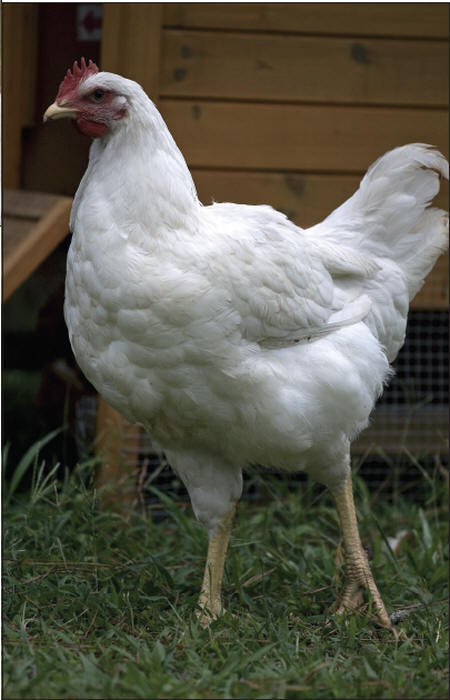
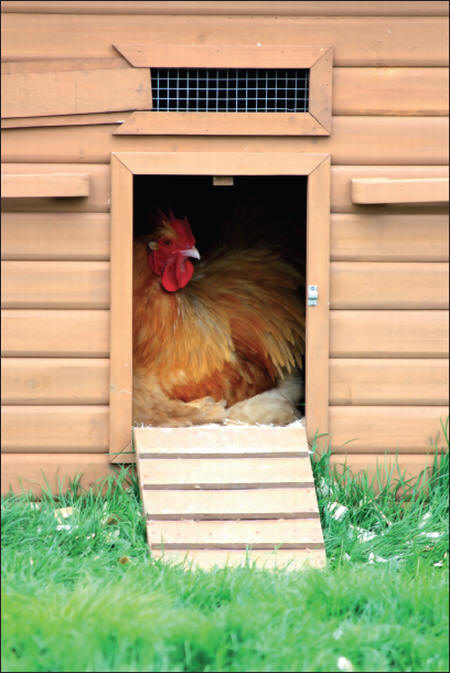
This pitched roof chicken coop consists of a pitched roof mounted on three boards, 6 feet high. This coop is 3 feet wide and 2 feet deep. Nail slats across the front to prevent the hen from getting out but to allow the chicks to enter and exit freely into a small, fenced-in area surrounding the coop.
The coop pictured above is similar to the pitched roof chicken coop except that there is a canopy that keeps the rain out and shades the interior of the coop so it does not become too warm. This coop is 3 feet long, 2 feet wide, and 30 inches high at the front and 24 inches high in the back. The coop can be constructed from boards with matched edges and should be raised an inch or two above the ground to ensure the floor remains dry. Tack a piece of light canvas or muslin to the roof to serve as the awning.
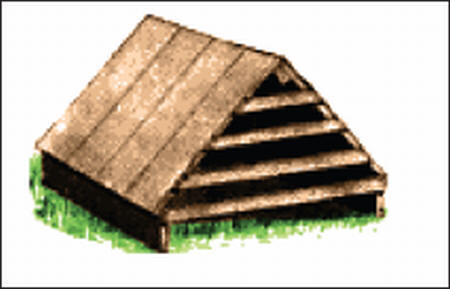
A pitched roof chicken coop.
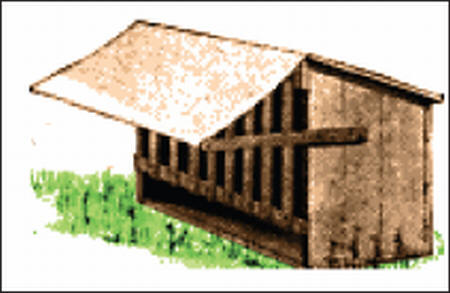
Chicken coop with canopy.
This henhouse has a scratching shed, which allows the chickens access to the open air while still being protected from the elements.
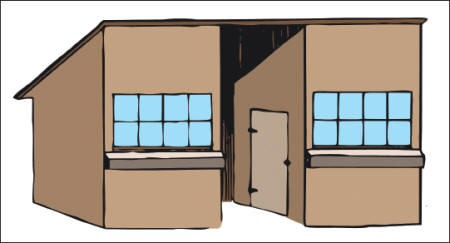
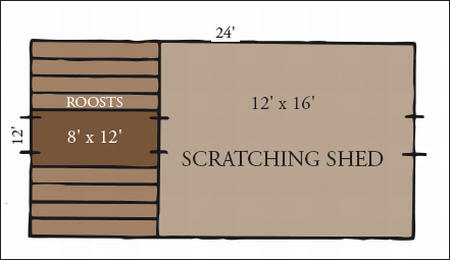
Plan for a henhouse with a scratching shed.
Practical Henhouse
This simple and efficient henhouse has a shed roof and, as most poultry houses should, faces toward the south. This house can be up to 10 feet wide and as long as you need to accommodate your chickens.
A scratching shed is in the center of the building and has windows that let sunlight in. The sleeping quarters should be kept warm. An open, wire-enclosed front for the scratching shed should be included, too. The roosts should be made movable, and fresh bedding should be kept on the floor of the henhouse.
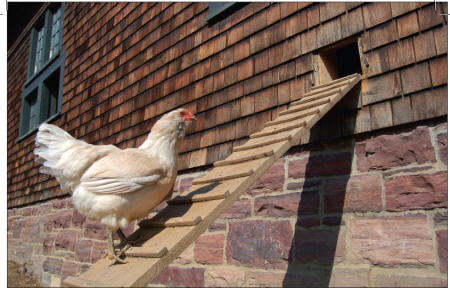
You can build a simple ramp to give your chickens easy access to the coop.
The roof of the henhouse should project out 1 foot over the south, east, and west sides. It should also be 5 inches higher than the siding, allowing for free ventilation. Two large windows will admit light and warmth into the hen-house. A laying box should extend the entire length of the room and must be divided into compartments and covered with a hinged lid. This allows the eggs to be gathered simply by raising the lid from the outside. Make sure the floor is cleaned weekly to keep out disease. The inside of the walls should be whitewashed often to keep out moisture and pests.
Two-Room Henhouse
This two-room henhouse has a south-facing front to allow ample sunlight and warmth into the house. It can be made as large as 10 x 12 feet and should be constructed of wood or timber planks. It is divided into two rooms by a partition made out of wire netting. This henhouse can serve two separate yards. A fence constructed in the middle of the house yard should join the center of the front of the building (and at the back as well if you so desire). In this house, both hens and roosters can be kept and are easily separated while allowing each enough space and exercise.
A two-room henhouse with a south-facing front.
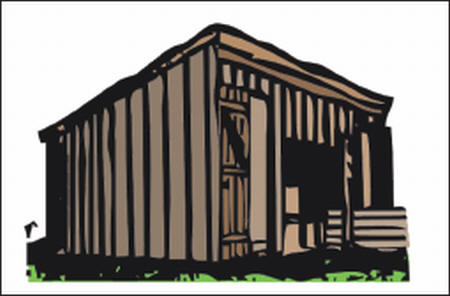
The platform and perches should be constructed inside of each room. When the perches are in need of cleaning, they are raised up against the wall in the house, in a perpendicular position. To clean the trough, the perches and platform are raised perpendicular to the floor.
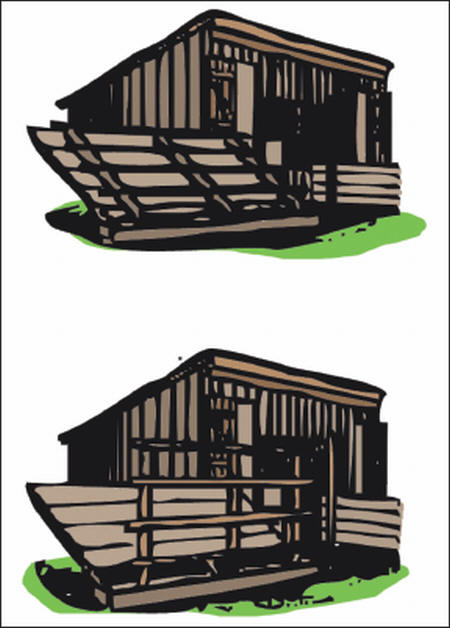
These pictures show how the perches can be moved to allow for easy cleaning.
Duck Houses
Ducks, while they can survive rather well in any type of poultry house, are happiest when they have either a stream or pond in which to swim, bathe, and gather food. If you have a stream or pond on your property, situating a duck house nearby will help ensure that the duck eggs are safe and secure.
If you are raising a good number of ducks, your duck house should be about 30 feet long and 12 feet high. Doors should be situated in the front of the house and the house should have a few small windows that can be slid open to allow fresh air to circulate within the duck house. The rear of the house should hold the nests (boxes open at the front). A small door should be situated behind each nest so the eggs can be easily removed.
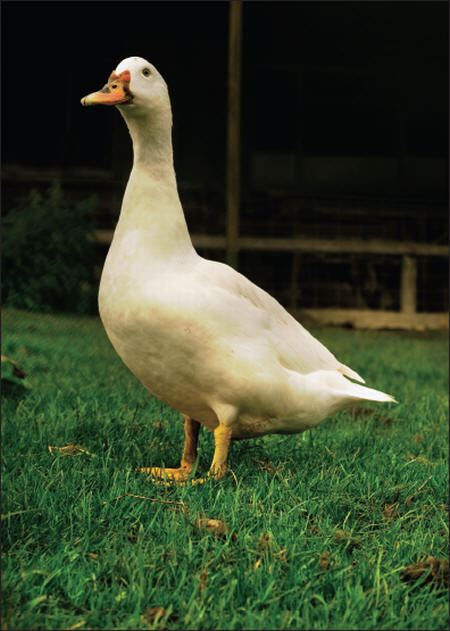
A simple duck house.
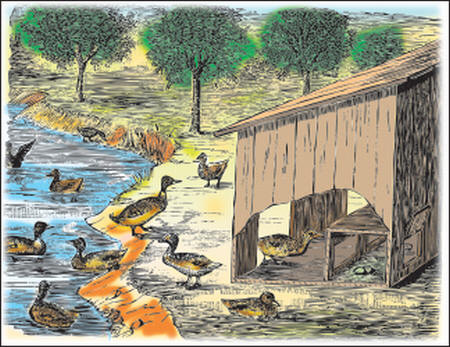
You can use a strip of wire netting to enclose a small, narrow yard in the front of the house. Do not use twine netting, however, as the ducks could get their heads twisted in it and strangle themselves.
Easy, Creative Coops
If you don’t have much space in your yard and only have a few chickens to keep, very good coops can be made at a very small cost from items found around your house, yard, or at rummage sales:
1. Barrel Coop
a. First, drive shingle nails through the hoops on both sides of each stave and clinch them down on the inside.
b. Divide the barrel in half, if it is big enough, by cutting through the hoops and the bottom.
c. Drive sticks into the ground to hold the coop in place, and drive a long stick at each side of the opened end just far enough from the coop to allow the front door to be slipped in and out.
d. The night door can be made from the head of the barrel or any solid board, and the slatted door, used to confine the hen, can be made by nailing upright strips of lath to a cross-lath at top and bottom.
2. Box Coop
a. Find a box that is roughly 2 to 2½ feet long, 16 inches deep, and 2 feet high and saw a hole, d, in one end.
b. Strengthen the box with narrow strips of wood, b, c, on each side of the hole. This acts as a groove for the door, a, to slide in. By doing so, you will have a sliding door that opens and shuts easily.
c. The front of the coop is enclosed with lath, or narrow strips, placed 2½ to 3 inches apart. The top should be covered with a good grade of roofing paper to make it completely waterproof.
Floor plan for the duck house.
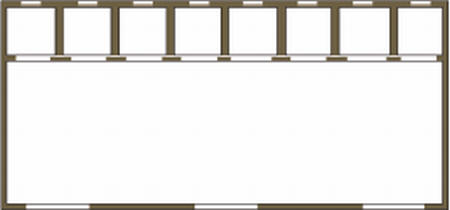
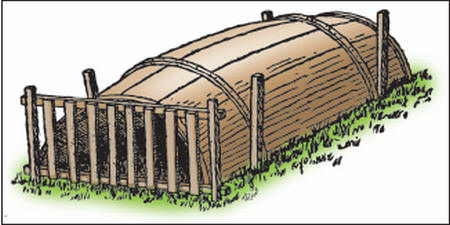
A barrel chicken coop.
3. Portable Coop—This type of coop will allow you to have a fresh yard for your chickens and other poultry to scrounge in and is easily transported to any place on your property.
a. The coop is built of ordinary material on a base frame and with a V-shaped roof and side frames. The preferred length of the coop is about 2 feet and the yard should be around 3 to 4 feet.
b. The ridge pole is extended, as shown at each end, to form a handle.
c. If desired, the hen may be allowed to freely roam the yard or can be contained within the coop by slats, as is pictured in the drawing.
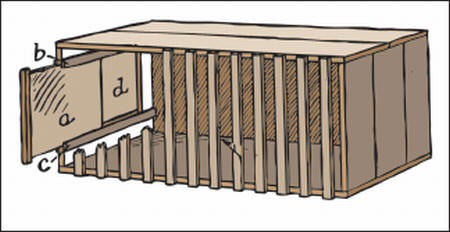
A simple box coop.
A portable chicken coop.
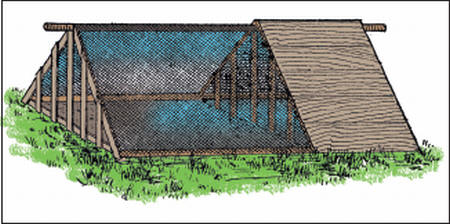
Poultry House Aids and Other Considerations
Folding Chicken Roost
This roost is made of 3-inch boards cut to any desired length that will fit within your poultry house. A small bolt fastens the upright pieces at their top ends and the horizontal pieces are fastened on with nails. This roost can be kept at any angle and may be quickly taken out of the house when it is time to clean. This sort of roost will accommodate more fowl in the same space than the flat kind.
Keeping Rats and Mice Out of the Poultry House
If you are building a permanent poultry house, you should try to make it as rodent-proof as possible. If rats and mice can easily enter your poultry house, they will not only steal eggs and spread diseases, but they could scare or even harm the fowl. Cheap and efficient walls can be made of small fieldstones in this way:
A folding chicken roost.
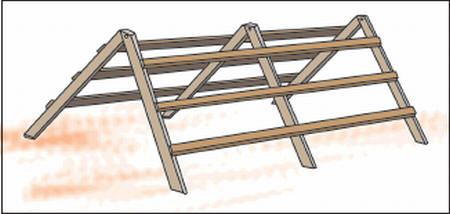
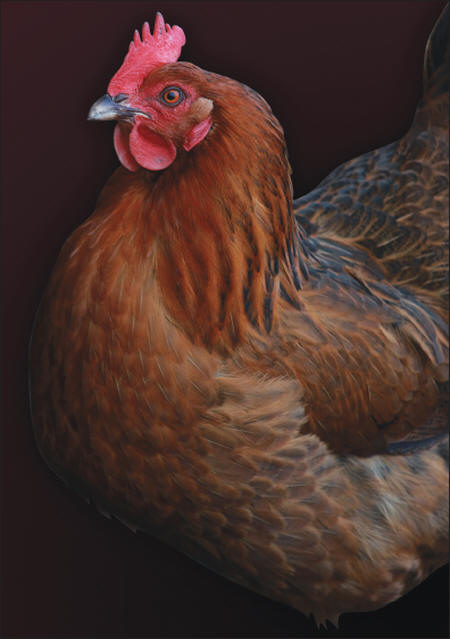
1. Dig trenches for the walls below the frost line.
2. Drive two rows of stakes into the trenches, one row at each side of the trench.
3. Set up boards in between the stakes. The boards will hold the stones and cement in place until the cement hardens. The top boards should have a straight upper edge and should be placed level to determine the top of the wall.
4. Place two or three layers of stone in the bottom of the trench, pour in thinly mixed cement, and pound it in. Repeat this until the desired height is reached.
5. The top of the wall should be smoothed off with a trowel and left until the cement completely hardens. The side boards can now be removed and the poultry house built.
Winter Care of Fowl
If chickens and other fowl are not kept warm in the winter, they will stop growing, cease laying eggs, and can become ill. There are several ways you can winterize chicken coops to ensure your birds’ comfort and well-being.
Especially if you live in colder climates, having a house with hollow or double side walls will help keep your fowl warm during the winter season. Buildings with hollow side walls are warmer in the winter and are also cooler in the summer. They do not collect as much severe frost and result in less moisture seeping into the henhouse once the frost melts.
The outside walls of chicken coops can be plastered or lined with matched boards and the spaces between the boards filled with wood shavings, sawdust, or hay. The floor should be covered with several inches of dry sand, wood shavings, or straw, and the ventilating holes near the roof should be partly stopped up or shutters arranged to close most of them in very cold weather. You don’t want to seal the place up completely, though. Nothing is more important to the health of fowl than pure air. Birds breathe with great rapidity and maintain a relatively high body temperature, so they need plenty of oxygen.
Constructing a solid, insulated roof for your poultry house for the winter is very important. A roof can be built either by sealing the inside with material to exclude draughts or by placing roof boards close together and covering them thoroughly with tarred paper before shingling. An ordinary shingled roof allows too much wind to come into the house and could cause your fowl to get frosted combs or wattles. If this happens, there will not be much, if any, egg production in the winter months.
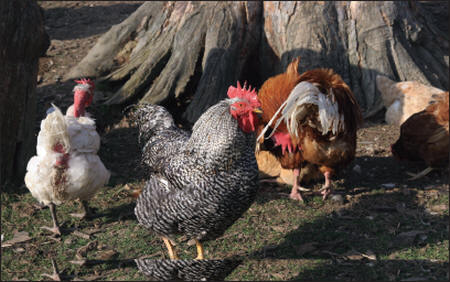
Hanging curtains in front of the perches is also a great way to keep your fowl warm during the winter months. Make these curtains of burlap and hang them from the roof in such a way that the perches are enclosed in a little room. Make sure the curtains are long enough to touch the floor all around, and sew the edges of the burlap together, except at the corners. At night, the corners can be pinned together to keep the birds from leaving their sheltered perches. This pseudo–sleeping room allows air to move in without creating drafts and it also helps retain the birds’ body heat. This maintains a comfortable temperature for the birds during cold, winter nights.
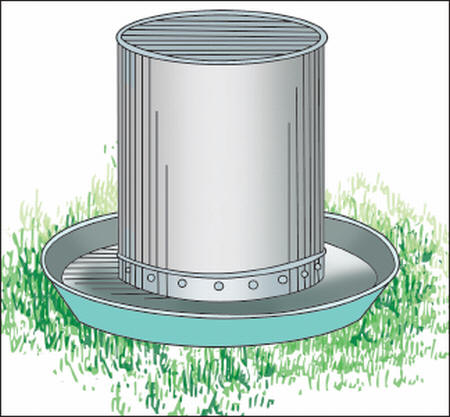
A drinking fountain for your chickens can be made with a can or bucket and a tray. Cut out one end of the can and poke holes along the edge as shown. Fill with water, cover with a shallow tray, and turn the whole thing over quickly. Chicks will be able to drink water easily without risk of drowning.